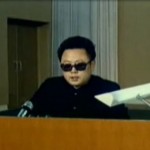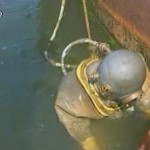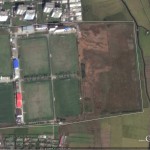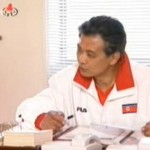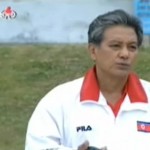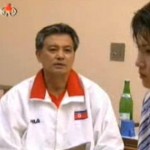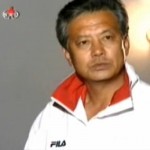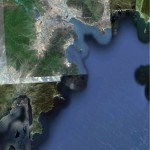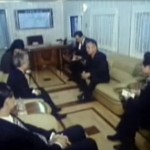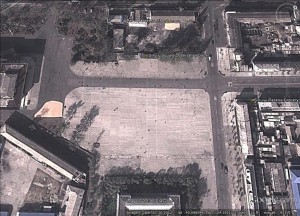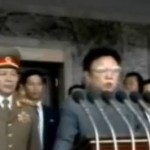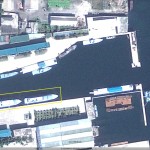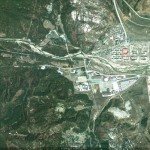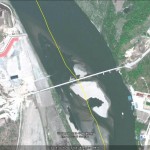
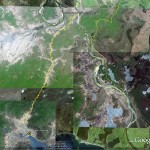
Pictured above (Google Maps): The Wonjong Bridge and route traveled by Chinese drivers from the border to Rason
UPDATE 6 (2011-6-15): Here is a great news video of the Chinese driving tour:
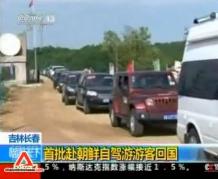
Click image to watch video at YouTube
UPDATE 5 (2011-6-10): Barbara Demick writes in the L.A. Times:
No doubt the most attractive part of the package for China is the access to the port in Rajin, part of a larger special economic zone known as Rason. In 1860, China’s weak Qing dynasty signed a treaty that ceded a long strip of coastline to Russia, leaving Chinese Manchuria landlocked. The use of the port in Rajin makes it easier to transport raw materials from the resource-rich region of northeastern China to the industrial hubs in southern China. In December, the Dalian-based Chuangli group, which had spent $3.6 million renovating the port, shipped 20,000 tons of Manchurian coal through the North Korean port to Shanghai.
“It is faster and cheaper to ship through North Korea’s port than to use the railroads,” said a businessman who was in Rajin this week as preparations were underway for the groundbreaking. “Everybody in Rajin is very excited about what the Chinese are doing. They think it will bring jobs.”
UPDATE 4 (2011-6-9): KCNA coverage of the Hwanggumphyong ground breaking ceremony also mentioned developments in Rason:
The [Hwanggumphyong] ceremony was followed by announcing the start of the reconstruction of the Rajin Port-Wonjong road, ground-breaking ceremonies of Athae Rason Cement Factory and the Rason, DPRK-Jilin Province, China High Efficiency Agricultural Model District and departing ceremonies of Chinese domestic freight transit transportation via Rajin Port and private car tourism as the first phase projects for the start of the joint development of the zone.
UPDATE 3 (2011-6-10): China’s Global Times reports on the Chinese business tour:
The first self-drive tour from China to North Korea started on Thursday, with around 100 tourists setting off from Changchun, Jilin Province, to Rason, North Korea, China News Service (CNS) reported.
A total of 24 vehicles carrying around 100 travelers including well-known entrepreneurs, officials with the Changchun Tourism Bureau and provincial government took part in the tour, according to a staff member surnamed Wang with the publicity department of the China Youth Travel Service (CYTS) Tours Corporation Jilin Branch, which organized the tour.
“We’ve spent more than a month preparing for the activity. We sent invitations to tourists and negotiated with the Rason government,” Wang told the Global Times on Thursday.
The tour will last from June 9 to 11, and the cost for each tourist was more than 1,000 yuan ($149), an anonymous staff member with the executive office of the CYTS Tours Corporation Jilin Branch told the Global Times on Thursday.
After assembling at the Changchun Exhibition and Conference Center on Thursday morning and identifying each car with a number, the tourists began their journey at 7 am and planned to reach Hunchun, the border city in Jilin Province that leads to North Korea, in the afternoon, according to the CNS report.
“The 24 vehicles were all provided by the tourists themselves, but we have dispatched a car to lead them and they were all given interphone sets in case some of them fall behind,” she told the Global Times on Thursday.
After passing through Hunchun, the tourists will reach Rason district and tour guides dispatched by the Rason government will lead them to visit Rajin Port and Rajin Bay.
There, they will be able to enjoy children’s performances and also visit local scenic spots, according to the staff member with the executive office of the CYTS Tours Corporation Jilin Branch.
“There were so many people who called to ask about this activity, so I believe we will organize a second tour in the near future,” she told the Global Times.
The North Korean government plans to develop Rason, located in the border area between China and North Korea, into an international economic zone. At the end of May, the North Korean government allowed Chinese tourists to make the self-drive trip to Rason to enjoy its scenery, according to CNS.
“Allowing self-drive tours from China to North Korea means a lot to both countries, because it will increase the interaction and enhance mutual understanding between the two peoples, and consequently, enhance friendly relations between the two countries,” Yang Zhenzhi, a professor at the School of History and Culture (Tourism) with Sichuan University, told the Global Times, adding that the decision will also help to boost economic ties between the two countries.
UPDATE 2 (2011-6-4): According to an earlier report in the Donga Ilbo a “groundbreaking ceremony” for the Rason area will also take place Thursday (June 9). No doubt this will take place just before the convoy of Chinese investors crosses into the DPRK. According to the article:
Sources in China`s Yanbian Autonomous District in Jilin Province and Dandong in Liaoning Province said Friday that the groundbreaking ceremony for the special district in Rason Special City will be held Thursday and that for the development of Hwangkumpyong in the Yalu River near Shinuiju will come Tuesday.
UPDATE 1 (2011-6-6): The news out today indicates that, as earlier reported (see original post below), a convoy of Chinese investors will travel the new road from Wonjong to Rason to explore investment opportunities. There are a few interesting differences between the time the story was originally published (in April) and today:
Firstly, and the least interesting point, the “investment convoy” is about nine days behind the original schedule. Originally the convoy was to depart for the DPRK on June 1. The convoy now appears to be departing on June 9.
Secondly, the convoy appears to be operated by a different Chinese tour company. Back in April the convoy was being coordinated through the Sanjiang International Travel Agency in Hunchun. The convoy departing this week, however, is run by CYTS Tours. I do not know enough about either of these businesses to speculate on treasons for the last minute switch in partners.
Thirdly, the cost of the trip has increased significantly. In April the Sanjiang Travel Agency said the trip would cost 680 Yuan. Now CYTS Tours says the cost will be 1450 Yuan per person, and the convoy size will be limited to 30 vehicles.
Here is the most recent report in the Donga Ilbo:
Chinese nationals can start traveling Thursday to Rason, a free trade zone in North Korea`s northeastern region, with their own cars for three days.
This is in line with the development plan linking the Chinese cities of Changchun, Jilin and Tumen that the Chinese government is promoting, China’s Xinhua News Agency said Friday.
For starters, the service launched by CYTS Tours will begin with fewer than 30 cars. Travel costs will be 1,450 yuan (224 U.S. dollars) per person, including lodging and eating. Whether anyone has applied remains unknown, however.
People who will start from Changchun Thursday will drive 500 kilometers to Hunchun in Yanbian Korean Autonomous Prefecture and then enter North Korea through the maritime customs at Quanhe. After crossing the Tumen River, they will go through immigration procedures at the customs office in the North Korean village of Wonjeong-ri and then go to Rason through a Hunchun-Rason road under construction.
The travelers will tour the port of Rajin and then tour Rajin Bay by boat. They will watch a children’s show and visit Sea Village and Wang Hai Guo, where the late founder of North Korea Kim Il Sung visited.
A source at CYTS Tours said, “The product was designed as a part of the (Chinese) government’s travel development plan for Changchun, Jilin and Tumen.”
ORIGINAL POST (2011-4-4): According to the Choson Ilbo:
North Korea is reportedly allowing Chinese motorists to drive to the special economic zone of Rajin-Sonbong so they can look around for investment opportunities there.
A spokesman for Sanjiang International Travel Agency in Hunchun, China on Friday said a group of Chinese motorists will tour Rajin-Sonbong and Duman near the North Korean-Chinese-Russian border under an initiative by the Tourism Bureau of Jilin Province on May 31-June 1. Sanjiang specializes in travels to the lower reaches of the Duman (Tumen) River in North Korea and Russia.
The two-day trip will cost 680 yuan (approximately W115,000) per person.
The Sanjiang staffer said small groups of Chinese motorists have gone to Rajin-Sonbong before, but this is the first large-scale trip organized by the Jilin provincial government and the first time tourists are visiting Duman.
The aim is apparently to lure Chinese investors to Rajin-Sonbong. Early this year, the North agreed with Hunchun city to build a large recreation center and park in its special economic zone.
Back in March 2008, the North allowed South Korean motorists to travel to the scenic Mt. Kumgang resort, but only four months later the tours were suspended after a South Korean tourist was shot dead by a North Korean soldier.
Related historical information:
1. Bridge on China-North Korea border being renovated (2010-4-13)
2. DPRK-China border bridge opens (2010-6-23)
3. Who uses Rajin’s Ports? (2010-5-23)
4. Rason port facilitates intra-China coal distribution (2011-1-4)
Read the original stories here:
China to allow nat`ls to travel to Rason, N.Korea, by car
Donga Ilbo
2011-6-6
Chinese Motorists to Tour N.Korean Investment Zones
Choson Ilbo
2011-4-5


